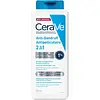What's inside
What's inside
 Key Ingredients
Key Ingredients

 Benefits
Benefits

 Concerns
Concerns

 Ingredients Side-by-side
Ingredients Side-by-side

Zinc Pyrithione 1%
AntiseborrhoeicWater
Skin ConditioningSodium C14-16 Olefin Sulfonate
CleansingDisodium Laureth Sulfosuccinate
CleansingDisodium Cocoamphodiacetate
CleansingSodium Chloride
MaskingGlycol Distearate
EmollientAmodimethicone
Sodium Lauryl Sulfoacetate
CleansingPPG-5-Ceteth-20
EmulsifyingCocamide Mipa
EmulsifyingPotato Starch Modified
Ceramide NP
Skin ConditioningCeramide AP
Skin ConditioningCeramide EOP
Skin ConditioningCarbomer
Emulsion StabilisingNiacinamide
SmoothingTrideceth-6
EmulsifyingTriethyl Citrate
MaskingSodium Hydroxide
BufferingSodium Benzoate
MaskingSodium Lauroyl Lactylate
EmulsifyingSalicylic Acid
MaskingSodium Polynaphthalenesulfonate
Emulsion StabilisingSodium Hyaluronate
HumectantCholesterol
EmollientPhenoxyethanol
PreservativeCoco-Betaine
CleansingPropylene Glycol
HumectantCitric Acid
BufferingCetrimonium Chloride
AntimicrobialCaprylyl Glycol
EmollientXanthan Gum
EmulsifyingPhytosphingosine
Skin ConditioningPolyquaternium-10
Acrylates Copolymer
Benzoic Acid
MaskingZinc Pyrithione 1%, Water, Sodium C14-16 Olefin Sulfonate, Disodium Laureth Sulfosuccinate, Disodium Cocoamphodiacetate, Sodium Chloride, Glycol Distearate, Amodimethicone, Sodium Lauryl Sulfoacetate, PPG-5-Ceteth-20, Cocamide Mipa, Potato Starch Modified, Ceramide NP, Ceramide AP, Ceramide EOP, Carbomer, Niacinamide, Trideceth-6, Triethyl Citrate, Sodium Hydroxide, Sodium Benzoate, Sodium Lauroyl Lactylate, Salicylic Acid, Sodium Polynaphthalenesulfonate, Sodium Hyaluronate, Cholesterol, Phenoxyethanol, Coco-Betaine, Propylene Glycol, Citric Acid, Cetrimonium Chloride, Caprylyl Glycol, Xanthan Gum, Phytosphingosine, Polyquaternium-10, Acrylates Copolymer, Benzoic Acid
 Reviews
Reviews

Ingredients Explained
These ingredients are found in both products.
Ingredients higher up in an ingredient list are typically present in a larger amount.
Salicylic Acid (also known as beta hydroxy acid or BHA) is a well-known ingredient for treating skin that struggles with acne and clogged pores. It exfoliates both the skin's surface and deep within the pores to help clear out buildup, control oil, and reduce inflammation.
Unlike AHAs (alpha hydroxy acids), salicylic acid is oil-soluble. This allows it to penetrate into pores which makes it especially effective for treating blackheads and preventing future breakouts.
Salicylic acid is also known for its soothing properties. It has a similar structure to aspirin and can calm inflamed or irritated skin, making it a good option for acne-prone skin that is also sensitive.
Concentrations of 0.5-2% are recognized by the U.S. FDA as an over-the-counter topical acne product.
It can cause irritation and/or dryness if one's skin already has a compromised moisture barrier, so it's best to focus on repairing that before introducing this ingredient into your routine.
While salicylic acid does not increase sun sensitivity, it’s still important to wear sunscreen daily to protect your skin.
If you are looking for the ingredient called BHA or Butylated Hydroxyanisole, click here.
Learn more about Salicylic AcidSodium C14-16 Olefin Sulfonate is a cleansing agent made from a mixture of long chain sulfonate salts. It can also help produce foam.
This ingredient may be drying. We recommend speaking with a professional if you have concerns.
Water. It's the most common cosmetic ingredient of all. You'll usually see it at the top of ingredient lists, meaning that it makes up the largest part of the product.
So why is it so popular? Water most often acts as a solvent - this means that it helps dissolve other ingredients into the formulation.
You'll also recognize water as that liquid we all need to stay alive. If you see this, drink a glass of water. Stay hydrated!
Learn more about Water